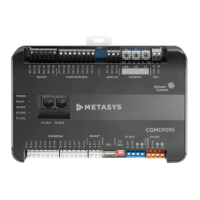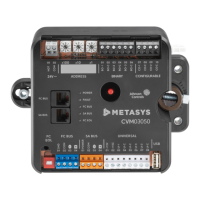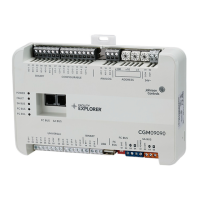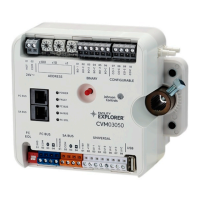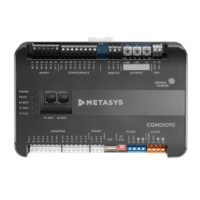CK721-A Installation and Operation CK721-A User Interface
24-10349-8 Rev. B 4-51
This document contains confidential and proprietary information of Johnson Controls, Inc.
© 2012 Johnson Controls, Inc.
The OTIS Compass interface is a high level interface that uses a TCP/IP network to
send elevator commands to the OTIS system, and to receive historical information
from the OTIS system. The OTIS system differs from typical elevator systems
because the floor selection is done outside of the elevator cab. Access to the floor
entry keypad (called a Destination Entry Computer or DEC) can be controlled by a
reader connected to a CK721-A panel, if configured to do so. The OTIS system
allows operation of the DECs in 4 different modes that define the availability of
floors and the order in which floors and badges are presented to the system.
Once the P2000 is connected to an OTIS Compass system, the P2000 is in full
control of what ea
ch DEC is able to do. This means that until an elevator is defined
in the P2000 system and its access parameters are configured, no use of the elevator
is permitted. Each CK721-A can control as many DECs as it has readers configured,
using a 1 to 1 mapping. The P2000 allows for the configuration of public use of a
DEC through the configuration of unsecured elevator entry points. The P2000 also
allows for configuration of secured entry points and the association of access rights
on a badge to those secured entry points. The P2000 supports the OTIS concepts of
“Allowed Floors” and “Authorized Floors” through its configuration screens. The
P2000 supports the ability to enter a PIN code on the DEC which is associated with
a badge in the P2000 system and grant appropriate access if allowed. The P2000 also
allows configuration of the ADA access and VIP access features, as well as the
default floor feature in the OTIS system. The operational modes of the OTIS
Compass system are currently defined as follows:
Mode 1 - Initially allows entry of a floor request or the presentation of a
badge. If a floor request is entered, and it is an allowed floor, an elevator is
dispatched. If a badge is presented first, that badges default floor is used to
dispatch an elevator, assuming the default floor is an authorized or an allowed
floor.
Mode 2 - A badge must be presented before a floor is selected and if the floor
is authorized or allowed, an elevator is dispatched. This is the common mode
of operation for secured elevator entry points.
Mode 3 - Initially allows entry of a requested floor. If the floor is allowed, an
elevator is dispatched. If the floor is not allowed, a request is made for the
user to provide a badge and if the badge presented authorizes the floor
requested, an elevator is dispatched. This is the most common mode of
operation for unsecured elevator entry points.
Mode 4 - A badge must be presented before a floor is selected, the badges
default floor is preselected for the user, but the user is given a short time
period to selected a different floor. If the floor selected after the time-out is
authorized or allowed, an elevator is dispatched.
In all modes, if an invalid badge is presented or an illegal floo
r is entered the user is
informed using the DECs display. If a valid combination of badge and floor
selection is made, the user is informed what elevator to board using the DECs
display. All transactions occurring at secured elevator entry points are logged in the
P2000 system.

